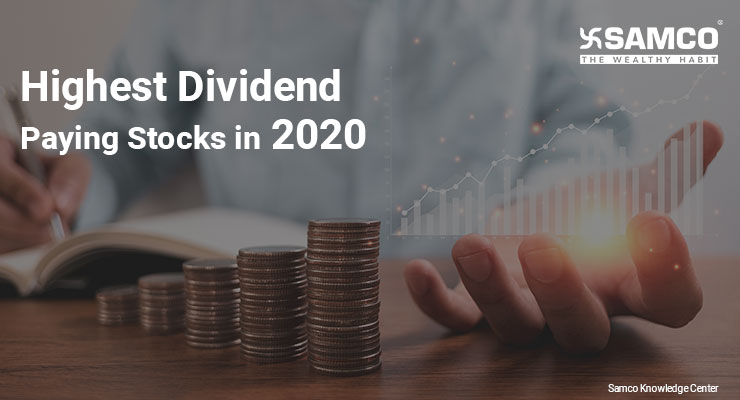 This following article will try to elaborate on following terms and questions which are much of investors' interests when it comes to dividend and other dividend related query.
This following article will try to elaborate on following terms and questions which are much of investors' interests when it comes to dividend and other dividend related query.
The article will highlight on:-
- What is dividend and its definition.
- What is dividend yield?
- How to calculate dividend yield
- What is ex-dividend date and other related terms
- Why you should consider investing in a high dividend paying stocks, and
- List of highest dividend paying stocks in India.
What is Dividend and dividend definition:
In layman’s language, dividend is the money shared by a company to its shareholders on regular basis depending on the profits earned (or reserves). As per law in India, there is procedure laid down in the Companies Act and the rules framed there under regulate the dividend payment which are as under:- Dividend can be paid only out of profits of the company from its ordinary operations in the relevant year or in the previous years after making provision for depreciation and amortisation in all such years
- Capital profits resulting out of sale of assets can be utilised for payment of dividend if and only if the same is realised.
- Dividend can be declared only after the minimum percent of the profits as prescribed in the Companies Act is transferred to reserves.
What are the dividend yield and dividend yield calculation:
Dividend yield is the dividend given by the company upon the market price of the share. It is also referred as the total dividend payouts done by the company upon the total market capitalization of the company , where the number of shares of the company is constant. It’s usually expressed in as a percentage. It is also to be noted that the dividend is usually declared on the face of the company’s share, meaning if any company declares that it is going to pay 250% dividend then it means that the dividend would be 250% of the face value of the share. So if the face value of the company is Rs 1 then the dividend payout would become 2.5 Rs per share. If anyone is holding let’s say 100 share of the company then the payout to the investor would become 2.5*100=250 Rs. The dividend yield would become as Dividend paid upon the current share price. Let say if the share price of the company in consideration is 250 Rs then the dividend yield would become as, Current dividend yield = Most Recent Full year dividend / Current share price = 2.5/250 = 0.01 = 1%Other dividend related terms and terminology:
Cash Dividend : The money paid to shareholders from company’s earnings or profits. Dividend: It’s the dividend which the company will payout to its shareholders. It is usually in %age and declared against the face value of the share. Dividend Declaration Date: The date on which the next dividend payouts would be done, is announced by the directors of the company. This usually have information on the size of the dividend payout, ex-dividend date, record date and payout date. Ex-Dividend Date: It’s the time between the announcement done and the payment of the dividend. It usually precedes the record date. At times it is one business day before the record date. Record Date: Record date is the date which is used to payout dividend to investors. For getting dividend, investor’s name should be present on records of the company as the holder of shares. So basically this date decides which all investors are eligible for dividend payouts.Why investors should look out for dividend-paying out stocks?
Investors should always see the dividend yield and the dividend payout history of the company for following reasons.- In general, if any company is paying dividend then its a proxy of the good financial health of the company
- It’s in one way of getting a return without actually exiting the position in the company. It’s more of a way of earning fixed income.
- In general, regular dividend payouts will keep the interests of investors up, therefore more investors would become interested in the company
List of highest dividend paying stocks in India:
The following table highlights the highest dividend paying stocks in India as of 2017-2018.|
S.No |
Company | Dividend Per Share (Last 5Yr Avg.) |
Dividend Yield (Last 5yr Avg.) % |
| 1 | Coal India Limited (CIL) | 21.68 | 7.85% |
| 2 | HCL Tech | 53.11 | 6.25% |
| 3 | HPCL | 22.38 | 5.44% |
| 4 | REC | 8.51 | 5.31% |
| 5 | NMDC | 6.36 | 5.07% |
| 6 | SBI | 13.83 | 4.20% |
| 7 | ONGC | 7.23 | 3.97% |
| 8 | BPCL | 19.19 | 3.89% |
| 9 | Hindustan Zinc | 10.92 | 3.53% |
| 10 | Infosys | 32.69 | 3.44% |
| 11 | ICICI Bank | 9.51 | 3.03% |
| 12 | IOCL | 9.3 | 2.40% |
| 13 | Vedanta | 7.09 | 2.30% |
| 14 | ITC Ltd. | 5.12 | 2.00% |
| 15 | Axis Bank | 10.52 | 1.97% |
| 16 | Wipro | 5.84 | 1.95% |
| 17 | Hero Motocorp | 68.81 | 1.90% |
| 18 | NTPC Ltd. | 3.26 | 1.84% |
| 19 | Tata Steel | 12.52 | 1.82% |
| 20 | GAIL | 8.03 | 1.73% |
| 21 | Tata Consultancy Services (TCS) | 36.93 | 1.36% |
| 22 | Bajaj Auto | 41 | 1.28% |
| 23 | L&T | 12.41 | 1.03% |
| 24 | HUL | 12.91 | 1.01% |
| 25 | M&M | 12.52 | 0.89% |
| 26 | Power Grid | 1.74 | 0.84% |
| 27 | Reliance Industries Ltd. (RIL) | 5.76 | 0.65% |
| 28 | HDFC | 10.27 | 0.62% |
| 29 | HDFC Bank | 4.84 | 0.27% |
| 30 | Maruti Suzuki | 18.45 |
0.23% |
 For more useful articles on trading, investing and market knowledge, visit our Knowledge Center section.
For more useful articles on trading, investing and market knowledge, visit our Knowledge Center section.




 Easy & quick
Easy & quick
Leave A Comment?